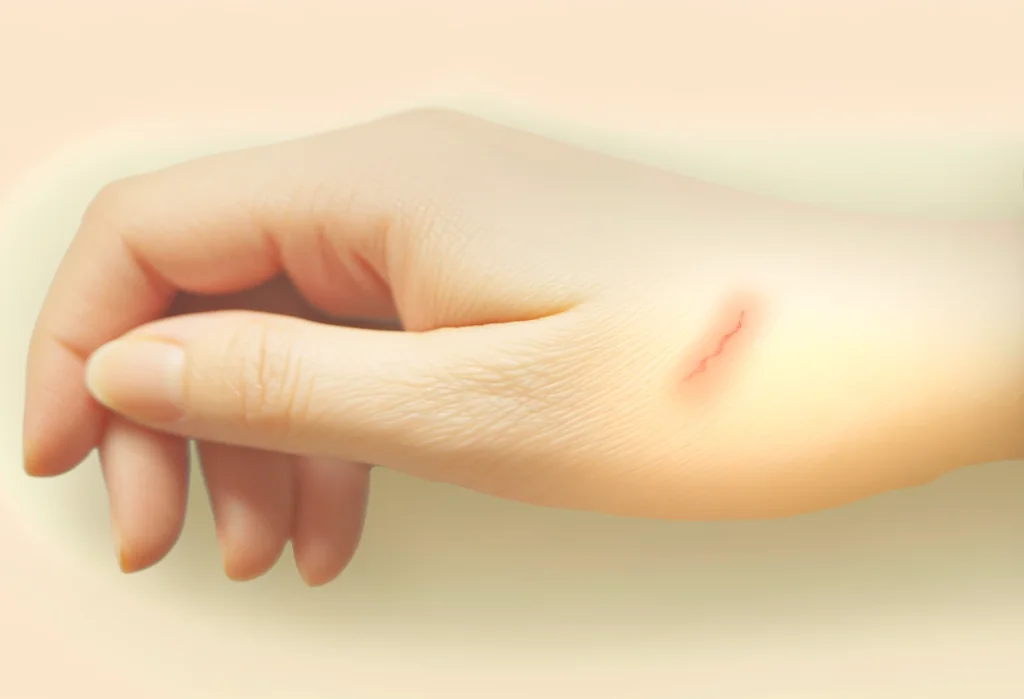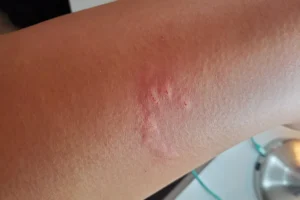Absolutely nothing screams “I’m a cat owner” more loudly than sporting a fresh set of scratch marks after a spirited play session with your furry friend. But when those battle scars puff up and resemble a mini mountain range on your arm, it’s hard not to wonder: what’s with the dramatic reaction?
You’re in luck because this blog post will unravel the mystery behind your skin’s puffy response to cat scratches.
Quick Takeaways:
- Clean and apply antibiotic ointment to cat scratches immediately to prevent infection.
- Monitor the scratch for increased swelling, redness, or pain, and consult a doctor if symptoms persist or worsen.
- Engage in safe play with interactive toys and keep your cat’s nails trimmed to minimize future scratches.
Why Do Cat Scratches Puff Up?
Ever wondered why a seemingly harmless scratch from your feline friend can turn into a swollen, red mess? Well, it all boils down to our body’s defense mechanism.
When a cat’s claw breaks our skin, it’s not just a physical tear; it’s an open invitation for bacteria residing on the cat’s claws or skin to waltz into our system. Our body, being the protective fortress that it is, doesn’t take this lightly. It launches an immune response to combat these foreign invaders, resulting in inflammation and swelling as it sends in the cavalry (a.k.a. white blood cells) to fight off potential infection.
Is it Normal For Cat Scratches to Swell?
Swelling after a cat scratch is like the body’s version of sounding the alarm—it’s pretty standard. However, it’s crucial to keep an eye on the severity and duration of this swelling. Understandably, mild swelling and redness are part of the healing process, but if the area around the scratch becomes increasingly swollen, red, or painful over a couple of days, it might signal an infection or an allergic reaction.
In rare cases, you might be dealing with something more serious like Cat Scratch Disease (CSD), caused by the bacterium Bartonella henselae. According to the Centers for Disease Control and Prevention (CDC), while CSD is generally not life-threatening, it’s nothing to brush under the carpet.
So, when is it time to ring the alarm bell? If swelling persists or worsens, especially if accompanied by fever, it’s time to head to the doctor. Listening to your body is key here. If it’s telling you something’s off through escalating discomfort, don’t ignore it.
What Can You Do to Reduce Swelling?
So, you’ve been on the receiving end of a cat scratch—ouch! Your immediate steps can significantly influence your healing journey. Let’s tackle the first aid protocol that might not only soothe the scratch but can also keep potential infections at bay:
-
Clean the Wound: Start with running lukewarm tap water over the scratch. Use mild soap to gently cleanse the area. This simple act washes away a good chunk of bacteria that hitchhiked into your skin.
-
Apply Antibiotic Ointment: A small dab of over-the-counter antibiotic ointment can go a long way. One to look out for is Neosporin. It’s a popular choice that can prevent infection and keep the wound moist, promoting faster healing.
-
Cold Compresses Work Wonders: For immediate swelling reduction, nothing beats a good old cold compress. Wrap some ice in a clean cloth and apply it to the area for about 10 minutes at a time. This not only reduces swelling but can significantly dial down the pain.
-
Elevation: If the scratch is on an arm or leg, keeping it elevated can help reduce swelling thanks to gravity doing its part in decreasing blood flow to the area.
-
Keep an Eye on It: Monitoring the scratch for signs of infection is crucial. If things seem to be heading south, consult a healthcare professional without delay.
Unique Tip: Did you know that honey has antibacterial properties? After cleaning the wound and before applying any ointment, dabbing a small amount of medical-grade honey on the scratch can provide an extra layer of natural defense against infection. It’s a sweet trick not many think about, but remember, this doesn’t replace the need for professional medical advice, especially if signs of infection appear.
Remember, taking prompt and proper care of a cat scratch is often all it takes to prevent any unwanted complications. Stay vigilant, follow these steps, and keep enjoying the love of your feline companions, minus the puffy souvenirs!
When Should You See a Doctor?
Getting scratched by your furry friend is a common part of being a cat owner. However, it’s crucial to remember that sometimes, even the most superficial scratch can escalate into a serious concern. So, when should you escalate your home care to professional medical attention? Keep an eye out for the following symptoms, which may indicate your scratch is more than just a surface wound:
- Excessive redness that spreads beyond the immediate area of the scratch,
- Warmth around the wound, which could indicate an infection,
- Pus or other discharge, a sure sign of infection,
- Fever or feeling unwell, which suggests your body is fighting an infection,
- Pain that escalates rather than subsides over time,
- Swelling that persists or worsens, which may be a sign of a bacterial infection, and
- If the victim of the scratch hasn’t had a tetanus shot in the past 5-10 years, especially if the scratch is deep.
These symptoms serve as red flags that the scratch might have introduced bacteria or other pathogens into your system, and it’s time to seek medical advice. Better safe than sorry, as the old adage goes. Your healthcare provider may prescribe antibiotics, recommend a tetanus booster, or offer other treatments to nip any potential problems in the bud.
Preventing Future Scratches
As cat owners, we cherish the playful moments with our kitties. Yet, those sharp claws can mean business! Let’s look at how you can keep playtime fun and safe for both you and your cat. Here are some practical ways to minimize the risk of future scratches:
-
Use Interactive Toys : Always use toys that keep your hands at a safe distance from those sharp claws. Wand toys or laser pointers can provide endless fun without putting your skin at risk.
-
Trim Your Cat’s Nails Regularly : Keeping your cat’s nails trimmed is a win-win. It’s less painful for your cat (think about those claws getting stuck in carpets or furniture) and safer for you. If you’re unsure about how to do this, ask your vet for a quick tutorial.
-
Interpret Your Cat’s Body Language : Cats are usually quite vocal (through their body language, that is) about their boundaries and mood. Tail flicking, ears pinned back, or hissing are clear signs to back off and give your fur baby some space.
-
Provide Plenty of Scratch Posts : Sometimes, a good scratch is what a cat needs to shed the outer layer of their claws and mark their territory. By providing ample scratching posts or pads throughout your home, you’re giving your cat a healthy outlet for their natural scratching instincts.
-
Unique Tip : Create a “safe word” or signal that you use whenever your cat’s play starts getting too rough. With repetition, your cat can learn to associate this word or signal with the idea that they need to ease up. While cats aren’t as easily trained as dogs, they’re smart creatures and can learn to associate certain words or sounds with actions or outcomes. This tip is rarely discussed but can be an effective strategy over time.
Remember, ensuring your cat has plenty of enriching activities and understands their boundaries can significantly reduce the risk of scratches. It’s all about understanding each other and living harmoniously under one roof. So, take these tips to heart, and you’ll enjoy a playful, scratch-free relationship with your feline friend.
Alex, a passionate animal lover, has experience in training and understanding animal behavior. As a proud pet parent to two dogs and three cats, he founded AnimalReport.net to share insights from animal experts and expand his knowledge of the animal kingdom.





